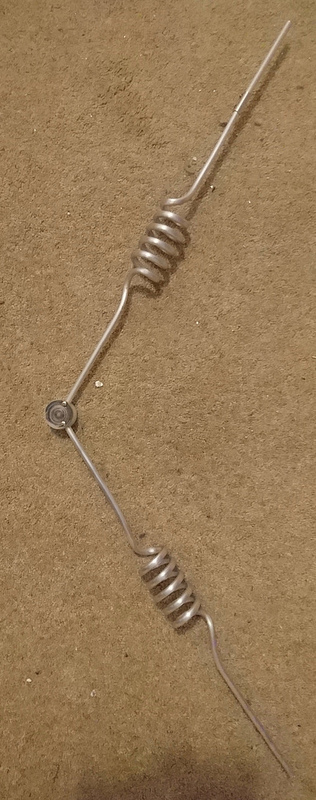A_and_C wrote:
As you said some composite aircraft have a conductor woven into the fabric, Boeing at one time used a very thin layer of cold metal spray on composite panels. Quite what the score is on the B787 I don’t know.
AFAIK the 787 composite is mostly carbon fibre which is quite conductive, so this should not be an issue. Kevlar, wood and glassfibre are in need of some conductivity solution, but not carbon.
Very interesting thread.
On my wooden aircraft (a MB2 Colibri), I use a Sirio Antenna that does not require a ground plane.

One of my ongoing projects is a shortened dipole antenna designed to fit behind the seat in my wooden Turbulent. I have an SWR meter and the tuning seems about right; still working on the feed and mounting. This is made of 1/4" aluminium tube. I worry about fatigue and am likely to try piano wire to similar dimensions as well.

Am I correct in thinking that any ground plane should be grounded to the aircraft earth ? and thus should show little to no resistance if continuity measured to the negative battery terminal ?
Seems you could spend the rest of your life researching best practices on this subject !
I don’t think that grounding wire is all that critical from the POV of the radio, because the shield of the coax cable is connected to the ground plane anyway. The coax forms a transmission line, all the way from the radio’s RF transmitter stage, which terminates on the antenna rod and its ground plane. The RF power does not return to the radio via the airframe (in the way e.g. the starter motor current returns to the battery via the airframe).
The grounding wire is critical for static dissipation into the airframe, and it needs to be really thick for lightning protection purposes.
For the purpose of the ground plane acting as a shield for RF, what matters is a low inductance connection to the airframe, which is not the same as low resistance. Practically speaking this means a short thick wire. The battery terminal is irrelevant.
So I would get some ~3mm diameter wire.
One more question if I may, in trying to get as large a ground plane as I can, is it significant that the aerial would not be able to be centered on the material ?
That will depend very much on their relative sizes and how off-center it is. However, the truth of the matter is that even if you were to give me a quantitative question, I couldn’t personally give you a quantitative answer.
I think if you’re designing your own antenna the important thing is to use a SWR meter so you can avoid damaging your radio (perhaps worth using a handheld for testing if you have one) and the rest will be empirical. If it works, it works.
I found this document quite helpful in planning my own shortened dipole antenna:
http://chrusion.com/public_files/InvVeeAntenna4ULs_rev3.pdf [ local copy ]
There are loads of radio amateur webpages with calculators for working out ballpark element lengths, turns etc…
I don’t think it needs to be centred if the ground plane is big enough.
This suggests that the ground plane needs to be at least 1/4 of the wavelength in diameter, so for aviation VHF this comes to 0.6m diameter. That is more than most people implement, I reckon…
Thanks to all for your help, I will post back and report on how my ground plane works.